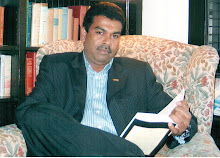
Caption: K. Bala, the team manager of the NST Editorial hockey team holding the trophy after the team emerged champion in the NST Inter-Department hockey tournament. Three others in this picture - John Pillay, M.A. Razman (aka Rattan Singh) and C. Navaratnam - have since passed on.
I lost yet another journalism sifu today.
K. Bala, who used to send shivers down the spine of every journalist I know at NST and Malay Mail, died in his sleep in Pulau Langkawi last night. He has been spending a lot of time in this legendary island upon his retirement some 15 years ago. He grew so much fondness for this island that even in his ill-health, he visited the island on and off.
Bala was a taskmaster, but never stinged on passing on his knowledge to young reporters. I was among them. He scolded us everyday, made sure we got out of the office to meet contacts and made us sit next to him when he was clearing our stories. As much as he grumbled, he taught us.
He did not spare the rod and did not spare the harsh words. But when it was end of the year and bonus time, he was fair in the performance appraisal. Many of my colleagues can vouch for that.
There are many stories about Bala. If I decide to write a book in future, perhaps he will take up a whole chapter.
Saiful, Kams and I had made plans to visit Bala one of these days. That didn't take place because the three of us couldn't actually agree on a suitable time. We now have to live with the regret that we didn't.
Goodbye Bala. Thank you. The country's journalism fraternity mourns your passing. May you rest in peace.






